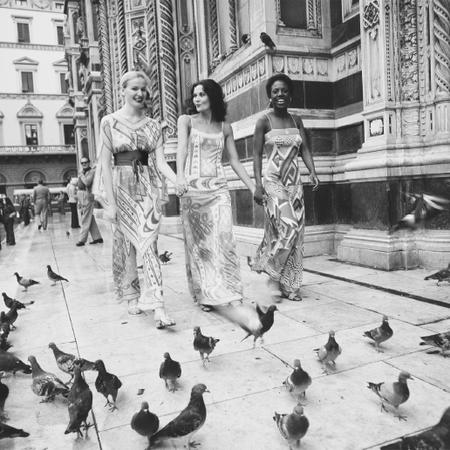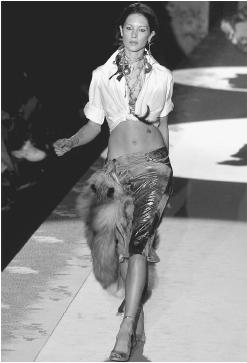Emilio Pucci - Fashion Designer Encyclopedia
Italian designer
Born: Marchese Emilio Pucci di Barsento in Naples, 20 November 1914. Education: Attended the University of Milan, 1933-35, University of Georgia, 1935-36, Reed College, Portland, Oregon, 1936-37; M.A., 1937; Ph.D., University of Florence, 1941. Family: Married Cristina Nannini di Casabianca, 1959; children: Alessandro, Laudomia. Military Service: Bomber pilot in the Italian Air Force, 1938-42. Career: Oylmpic skier, 1934; women's skiwear designer, White Stag, for Lord & Taylor department store, 1948; freelance fashion designer, from 1949; first Pucci shop established in Capri, 1949, Rome, Elba, Montecatini, from 1950; president, Emilio Pucci SrL, Florence, and Emilio Pucci, New York, from 1950; vice-president for design/merchandising, Formfit International, 1960s; business run by family after death, 1992; daughter Laudomia assumed design duties; men's ties, swimwear reintroduced, 1998; new womenswear designed by Stephan Janson, 1998; majority share acquired by LVMH,

Publications
On PUCCI:
Books
Mulassano, Adriana, I mass-moda: fatti e personaggi dell'Italian Look, Florence, 1979.
Aragno, B.G., editor, 40 Years of Italian Fashion [exhibition catalogue], Rome, 1983.

Kennedy, Shirley, Pucci: A Renaissance in Fashion, New York,1986, 1991.
Casadio, Mariuccia, Emilio Pucci, New York, 1998.
Articles
Schiff, F., "If You Knew Pucci," in Interview, September 1974.
"Founding Father of the Signature Print," in the Times (London), 1September 1976.
Shields, Jody, "Pucci," in Vogue, May 1990.
Hochswender, Woody, "Pucci Redux," in the New York Times, 8 May 1990.
Porti, Anna Gloria, "Mai come adesso é Pucci," in Vogue (Milan),September 1990.
Young, Lucie, "The New Pucci Coup: Psychedelic Swirls Back," in Metropolitan Home (London), December/January 1990-91.
Morris, Bernadine, "Emilio Pucci, Designer of Bright Prints, Dies at78," in the New York Times, 1 December 1992.
"Prince of Prints," [obituary] in People, 14 December 1992.
"Emilio Pucci," [obituary] in Current Biography, January 1993.
Goldstein, Lauren, "Pucci Adds New Punch to Spring Presentation," in DNR, 1 December 1997.
Forden, Sara Gay, "Tribute to Pucci Leads to Birth of a Collection," in WWD, 22 December 1997.
Braunstein, Peter, "Pucci Conquers Cyberspace," in WWD, 30 July 2000.
Menkes, Suzy, "Pucci Picks an Eclectic Designer," in the International Herald Tribune, 31 October 2000.
***
Rising out of the ashes of European fashion after World War II, Emilio Pucci brought a spectrum of carefree colors to the rationed continent. His sportswear beginnings lent a casual air to his work, a welcome relief from recent austerity and a new meaning to the term "resort wear." The swirling freestyle patterns and fluid fabrics he used became internationally recognized and desired, copied by many but rivaled by few.
American Tina Lesser may have been earlier with her hand-painted silks, but Pucci quickly made them his own, covering the fine lustrous fabric with optical fantasies of geometric shapes. His color range came straight from an Aegean horizon, turquoise and ultramarine set against sea green and lime, or hot fuchsia and sunflower yellow. Pucci swept away the repetitive sailor styles and tailored linens of cruisewear and brought in a new air of ease and luxury with his breezy separates. He capitalized on the lull in British and French couture after the war that benefitted many American and Italian designers, and dressed the fashionable mondaine in bold ready-to-wear.
The government-backed presentations of Italian designers of the late 1940s provided an aristocratic Florentine backdrop for Pucci's collections, which were soon internationally popular, and he became increasingly aware of the importance of the American market to his success. His characteristic style was best seen in slim-legged trousers in fruity shades, which provided a sexy foil to loose-hanging tunics and classic shirts left to hang outside the waistband.
His collections encompassed more than just stylish but jaunty daywear. In 1961 he showed simple evening dresses with deep V-shape panels set into their sophisticated bias-cut silhouette. Pucci saw his greatest success in the 1960s; his psychedelic-patterned printed silks were seen everywhere. They were, and continued to be worn by celebrities, from early clients Marilyn Monroe and Jackie Kennedy to Madonna, all seduced by the light touch of his designs.
As his reputation grew, Pucci's distinctive patterns were aspired to by many; a Pucci scarf or vivid silk handbag provided the cachet of luxury. His name was seen on everything from gloves to small ornaments, yet by the 1970s his work, like that of other big fashion houses, seemed less in tune with the times. During the 1980s, Pucci ranges seemed irrelevant to the weighty tailored severity that preoccupied the fashion world. It was not until the start of the 1990s that the pure whirling colors of the Pucci label (by then directed by his daughter, Laudomia) were again universally embraced. His signature shapes and vivid patterns had already inspired a generation of Italian designers, notably Gianni Versace and Franco Moschino, and in 1991 the reinvigorated Pucci look was everywhere. It had been translated into the modern essentials—clingy leggings, catsuits, and stretch polo necks which continued the sexy feel of his work and contrasted perfectly with his airy shirts. His clothes sold out across the world as a new, younger audience took up the label, perpetuating its popularity, albeit on a less high profile level after the initial Pucci mania earlier in the year.
The eclectic use of surface pattern and innovative color combinations distinguishing Pucci's work have been widely emulated throughout the fashion strata. His use of color added a feeling of movement to his clothes, while the quality fabrics enhanced the fluid line. The classic separates he designed continued to be successful, while the addition of newer styles ensured that the label would continue as a vibrant note to fashion in the later 1990s after Pucci's death in 1992.
A rebirth of Pucci's distinctive prints for men, including swimwear, sleepwear and ties, was scheduled to arrive in U.S. in 1998, but not before a new collection of womenswear debuted in Florence in January. At a time when original Pucci designs brought in premium prices at vintage shops, the reissue of menswear was inspired. The fall/winter womenswear line, however, grew out of different circumstances. "The whole idea started during the Biennial exhibition in Florence last fall," Laudomia Pucci, a company's director, told Women's Wear Daily in December 1997. The tribute, arranged by her mother Crista, had garnered so much attention the family decided to introduce a 50-piece collection, mostly for women, designed by Milan-based designer Stephan Janson. "We decided on Stephan Janson to do the collection because he's young, well-traveled, and well-cultured," Laudomia commented, and Janson "will be able to live well in the Pucci universe."
In the 21st century, change came to Pucci by way of new ownership. In Feburary 2000 luxury conglomerate LVMH bought a controlling stake in the firm and initiated a rehaul of the Pucci image. Four new Pucci stores opened in Milan, Portofino, St. Moritz, and Palm Beach, followed by a segue into home furnishings. Next came the appointment of Puerto Rican designer Julio Espada as artistic director (Laudomia was named Image Director), and in 2001 came the launch of a snazzy Pucci website.
The online Pucci forum blended archival photos with newer images, with collections past and present. Laudomia believed the mix of "classic and contemporary" was worthy of special notice. "I don't think any fashion house with a history has tried to convey that dimension to an online audience," she remarked to Women's Wear Daily in July 2001. "They focus solely on now." The "now" of Pucci may be firmly rooted in the past, but is securely focused on the future.
—Rebecca Arnold;
updated by Owen James
Comment about this article, ask questions, or add new information about this topic: